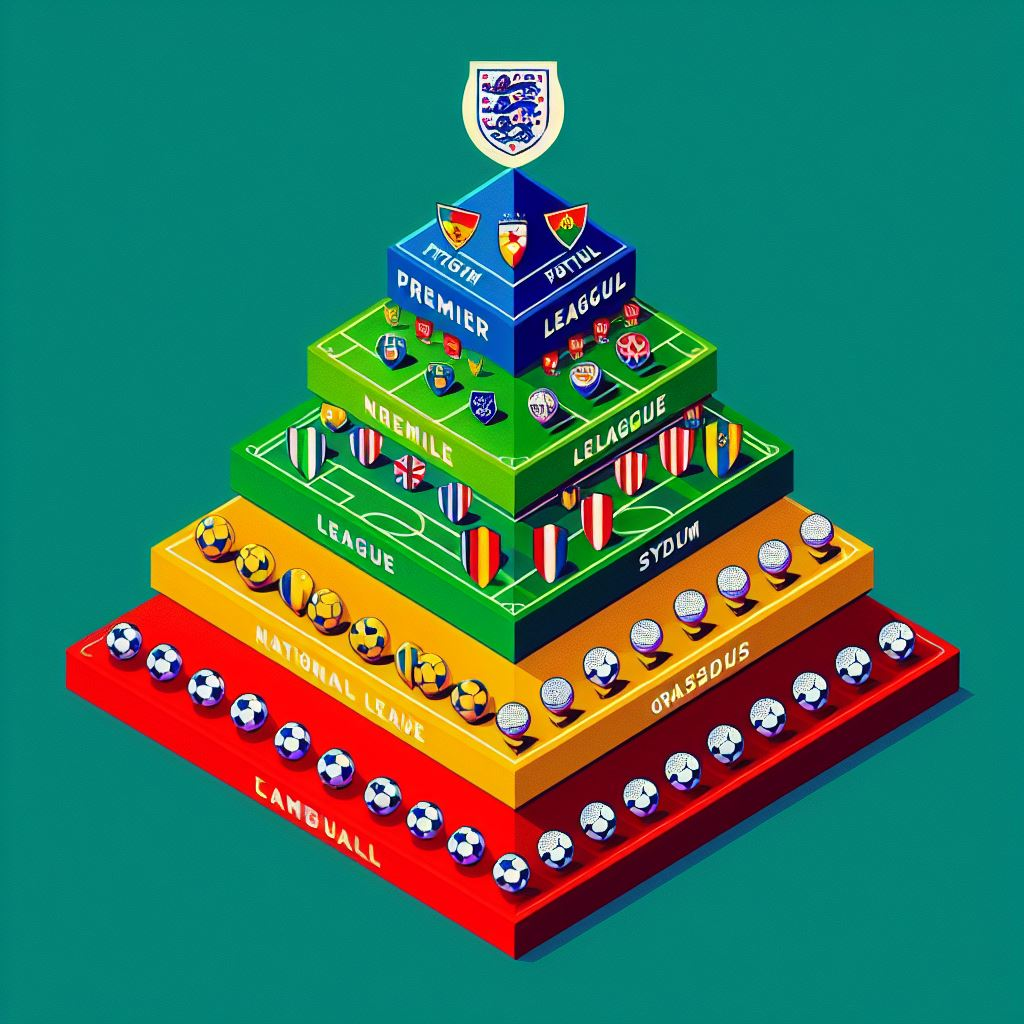Discover The Phenomenal English Football Pyramid Tiers
Introduction to the English Football Pyramid
The English football pyramid stands as a testament to the rich tapestry of the nation’s sporting heritage. It’s a hierarchical structure that encompasses various tiers, each representing a different level of competition and aspiration within the realm of football. At its summit sits the illustrious Premier League, revered worldwide for its intensity, talent, and drama on the pitch. Beyond this prestigious tier lies a network of leagues and divisions, each contributing to the vibrancy and diversity of English football.
As the pinnacle of the football pyramid, the Premier League commands global attention, with millions of fans tuning in to witness the electrifying clashes between top-flight teams. From Manchester United to Liverpool, Arsenal to Chelsea, these iconic clubs epitomize the essence of elite football, competing not only for domestic glory but also for international recognition in prestigious tournaments such as the UEFA Champions League.
Beneath the Premier League, the EFL Championship emerges as a battleground for aspiring teams eager to secure promotion to the top tier. Here, clubs fiercely vie for a coveted spot among the footballing elite, with the promise of lucrative television deals and increased exposure motivating their pursuit of success. The Championship’s competitiveness and unpredictability make it a thrilling spectacle for fans, with promotion playoffs adding an extra layer of drama to the season’s climax.
Meanwhile, League One and League Two offer a glimpse into the grassroots of English football, where smaller clubs and emerging talents seek to make their mark on the national stage. These tiers provide invaluable opportunities for player development and community engagement, embodying the grassroots ethos that underpins the football pyramid.
Beyond the professional leagues lie the realms of non-league football, where local teams and dedicated enthusiasts come together to celebrate the sport they love. From village greens to urban pitches, non-league football represents the heart and soul of English football, fostering a sense of camaraderie and passion that transcends divisions and hierarchies.
The Premier League: Top Tier Excitement
The Premier League stands as the pinnacle of English football, captivating audiences worldwide with its blend of skill, drama, and sheer excitement on the pitch. Established in 1992, the Premier League has evolved into one of the most prestigious and lucrative football competitions globally, attracting top talent from around the globe. With its high-profile matches and iconic stadiums, the Premier League offers unparalleled entertainment for football enthusiasts, drawing millions of viewers to screens across the globe.
At the heart of the Premier League’s allure lies its fiercely competitive nature, where every match is a battle for supremacy and every point counts in the pursuit of glory. From the intense rivalries between historic clubs like Manchester United and Liverpool to the emergence of new contenders such as Manchester City and Chelsea, the Premier League delivers a captivating blend of tradition and innovation, ensuring that fans are always on the edge of their seats.
Key fixtures in the Premier League calendar, such as the Manchester Derby, the North London Derby, and the Merseyside Derby, showcase the intense rivalries and passion that define English football. These matches are not just about points; they’re about pride, bragging rights, and the chance to etch their names into footballing history.
In addition to the on-field action, the Premier League’s global appeal is further enhanced by its commercial success, with lucrative television deals, sponsorships, and endorsements contributing to its financial prowess. The league’s ability to attract top sponsors and investors underscores its status as a powerhouse in the world of sports entertainment, with clubs benefiting from substantial revenue streams that enable them to invest in world-class talent and state-of-the-art facilities.
As the Premier League continues to evolve and adapt to the ever-changing landscape of modern football, one thing remains constant: its ability to captivate audiences and inspire a new generation of football fans around the world. With its blend of skill, drama, and passion, the Premier League stands as a shining example of the enduring appeal of English football.
EFL Championship: The Battle for Promotion
The EFL Championship serves as the battleground for clubs vying for promotion to the prestigious Premier League, offering a thrilling blend of competition, drama, and unpredictability. Situated just below the top tier of English football, the Championship boasts a fiercely contested league format, where clubs compete over a gruelling 46-match season for the chance to ascend to the pinnacle of the football pyramid.
With its fiercely competitive nature and high-stakes encounters, the EFL Championship attracts a global audience of football enthusiasts eager to witness the drama unfold. From nail-biting relegation battles to exhilarating promotion races, every match in the Championship carries immense significance, with clubs fighting tooth and nail to secure vital points and edge closer to their ultimate goal of Premier League promotion.
The Championship’s allure lies not only in its competitive fixtures but also in its ability to showcase emerging talents and future stars of English football. Many top-flight clubs scout the Championship for promising players, recognising it as a breeding ground for talent and potential. As such, the league serves as a platform for aspiring footballers to showcase their skills on a national stage, with the hope of catching the eye of scouts and managers from higher divisions.
One of the defining features of the Championship is its promotion playoff system, which adds an extra layer of excitement and tension to the end of the season. The top six teams in the league standings compete in a playoff tournament, with the winner earning promotion to the Premier League. These playoff matches are often characterized by intense drama and heart-stopping moments, as clubs battle it out for the chance to realize their dreams of top-flight football.
As the EFL Championship continues to captivate audiences with its blend of passion, competition, and talent, it remains a vital component of the English football landscape, shaping the destinies of clubs and players alike while providing fans with unforgettable moments of sporting drama.
Exploring League One: A Gateway to the Top
League One represents a crucial stepping stone for clubs aspiring to ascend the English football pyramid and reach the illustrious heights of the Premier League. Positioned as the third tier of English football, League One offers a competitive environment where clubs battle it out for promotion to the Championship while also striving to avoid relegation to League Two.
At the heart of League One’s appeal is its role as a gateway for clubs seeking to break into the higher echelons of English football. With promotion to the Championship offering the prospect of increased exposure, revenue, and prestige, clubs in League One approach each season with determination and ambition, knowing that success could propel them one step closer to their ultimate goal.
The competitiveness of League One is evident in the intense battles that unfold throughout the season, as clubs jostle for position in the league standings. From the top contenders vying for automatic promotion to the mid-table teams fighting for playoff spots, and the strugglers battling to avoid relegation, every match in League One carries significant implications for the clubs involved.
One of the defining characteristics of League One is its ability to showcase emerging talents and provide opportunities for young players to shine on the professional stage. Many promising footballers hone their skills in League One before making the leap to higher divisions or catching the attention of top-flight clubs scouting for talent.
In addition to its role as a platform for player development and club advancement, League One also holds a special place in the hearts of fans across the country. The passion and dedication of supporters, combined with the excitement of matchday experiences, create a vibrant atmosphere that adds to the allure of League One football.
As clubs continue to navigate the challenges and opportunities presented by League One, the division remains an integral part of the English football landscape, shaping the futures of clubs, players, and fans alike while contributing to the enduring appeal of the football pyramid.
League Two: Where Dreams Begin
League Two stands as a testament to the inclusivity and diversity of the English Football Pyramid, offering a platform for clubs from diverse backgrounds to compete on a national stage. As the fourth tier of the English football pyramid, League Two represents the starting point for many clubs’ journeys towards success and recognition within the footballing community.
Within League Two, clubs vie for promotion to higher divisions while also striving to maintain their status and avoid relegation to non-league football. The division is characterized by its competitive nature, with clubs fiercely battling it out over a gruelling season consisting of 46 matches, each with its own significance in the pursuit of glory.
For many clubs in League Two, success represents the fulfilment of long-held dreams and aspirations. Whether it’s securing promotion to League One or achieving stability within the division, the journey through League Two is filled with highs, lows, and moments of triumph that define the fabric of footballing culture.
One of the defining features of League Two is its emphasis on youth development and grassroots football. Many clubs within the division prioritize the nurturing of young talent, providing opportunities for aspiring footballers to showcase their skills and progress through the ranks. This focus on player development not only benefits the clubs themselves but also contributes to the overall growth and sustainability of English football.
In addition to its role as a breeding ground for talent, League Two also holds a special place in the hearts of fans across the country. The passion and dedication of supporters, combined with the unique matchday experiences offered by League Two clubs, create a vibrant atmosphere that adds to the charm and appeal of lower-league football.
As clubs continue to navigate the challenges and opportunities presented by League Two, the division remains an integral part of the English football landscape, shaping the dreams and aspirations of clubs, players, and fans alike while contributing to the rich tapestry of the football pyramid.
Beyond the Football League: Non-League Football
Non-league football occupies a unique position within the English football pyramid, representing the grassroots of the sport and providing opportunities for clubs and players outside the professional leagues to participate in competitive football. Situated below the Football League tiers, non-league football encompasses a diverse array of leagues, clubs, and competitions, each with its own distinct characteristics and appeal.
At the heart of non-league football lies a deep-rooted sense of community and camaraderie, with clubs often serving as focal points for local pride and identity. From small towns to urban neighbourhoods, non-league clubs bring people together, fostering a sense of belonging and unity that transcends the boundaries of the football pitch.
Non-league football offers a pathway for aspiring players to pursue their passion for the sport and showcase their talents on a competitive stage. Many professional footballers began their careers in non-league football, honing their skills and gaining valuable experience before making the leap to higher divisions. As such, non-league football plays a vital role in the development of talent within the English footballing landscape.
In addition to its role in player development, non-league football also provides opportunities for clubs to achieve success and recognition within their communities. Promotion through the non-league ranks can bring with it increased visibility, revenue, and prestige, allowing clubs to establish themselves as integral parts of the local sporting fabric.
One of the defining features of non-league football is its inclusivity and accessibility, with clubs of all sizes and backgrounds competing on equal footing. From amateur village teams to semi-professional outfits, non-league football welcomes clubs from diverse backgrounds, celebrating the diversity and richness of the footballing community.
As non-league football continues to thrive and evolve, it remains a vital component of the English football pyramid, embodying the grassroots ethos that underpins the sport while providing opportunities for clubs, players, and fans to engage in the beautiful game at a local level.
Promotion and Relegation Dynamics
Promotion and relegation dynamics are at the core of the English football pyramid, driving competition, drama, and excitement across all tiers of the game. The system operates on a simple yet powerful principle: clubs that perform well are rewarded with promotion to higher divisions, while those that struggle face the prospect of relegation to lower tiers.
At the top of the pyramid, promotion to the Premier League represents the ultimate goal for clubs competing in the Football League. Achieving promotion to the top flight not only offers financial rewards and increased exposure but also brings with it the prestige and status of competing among the elite clubs in English football.
Conversely, relegation from the Premier League can have significant financial and sporting implications for clubs, impacting revenue streams, player recruitment, and fan morale.
In the EFL Championship, promotion to the Premier League is fiercely contested, with clubs investing heavily in player recruitment, coaching staff, and facilities in pursuit of top-flight football. The Championship’s playoff system adds an extra layer of drama to the promotion race, providing an opportunity for clubs that narrowly miss out on automatic promotion to secure their place in the Premier League through a high-stakes knockout tournament.
In League One and League Two, promotion offers clubs the chance to progress through the footballing ranks and compete at higher levels of competition. For many clubs in these divisions, promotion represents a significant achievement, validating their efforts on and off the pitch and providing a platform for further growth and success.
Conversely, relegation can be a bitter pill to swallow for clubs, with the prospect of dropping down to lower divisions posing financial challenges and testing the resolve of players, staff, and supporters alike. However, relegation also offers clubs the opportunity to regroup, rebuild, and mount a challenge for promotion in the seasons to come, showcasing the resilience and competitive spirit that defines English football at all levels.
Overall, promotion and relegation dynamics form the backbone of the English football pyramid, driving competition, ambition, and excitement while ensuring that clubs are constantly striving to improve and achieve success on the pitch.
Impact on Clubs and Communities
The impact of the English football pyramid extends far beyond the confines of the pitch, shaping the fortunes of clubs and communities alike and leaving an indelible mark on the fabric of society. At the heart of this impact is the deep-rooted connection between football clubs and the communities they represent, with clubs serving as focal points for local pride, identity, and solidarity.
For many clubs, success within the football pyramid brings with it a host of tangible benefits, including increased revenue, sponsorship opportunities, and media exposure. Promotion to higher divisions can provide clubs with the financial resources needed to invest in player recruitment, stadium improvements, and community outreach programs, enhancing their standing both on and off the pitch.
Conversely, relegation can have significant financial implications for clubs, impacting their ability to attract sponsors, retain key players, and generate revenue through matchday ticket sales and merchandise. The loss of top-flight status can also affect the morale and confidence of players and supporters, leading to a period of uncertainty and adjustment as clubs adapt to life in lower divisions.
Beyond the financial aspects, the impact of the football pyramid extends to the social and cultural fabric of communities across the country. Football clubs play a vital role in fostering a sense of belonging and unity among residents, providing opportunities for people from diverse backgrounds to come together and celebrate their shared passion for the beautiful game.
Moreover, football clubs often engage in a wide range of community initiatives and outreach programs, using their platform to address social issues, promote inclusion and diversity, and support local charitable causes. From youth development programs to community coaching sessions, these initiatives help clubs to forge meaningful connections with residents and make a positive impact beyond the confines of the football pitch.
The English football pyramid has a profound impact on clubs and communities, shaping their identities, fortunes, and aspirations while fostering a sense of unity, pride, and belonging among football enthusiasts across the country.
Career Opportunities in Football Management
Football management offers a diverse array of career opportunities for individuals passionate about the sport and eager to make their mark in the industry. From coaching and scouting to sports science and administration, the world of football management encompasses a wide range of roles and responsibilities, each playing a vital role in the success and sustainability of football clubs at all levels of the game.
At the highest echelons of football management lies the role of the head coach or manager, responsible for leading and guiding teams to success on the pitch. Managers oversee all aspects of team performance, including tactics, training, and player selection, utilizing their strategic acumen and leadership skills to navigate the challenges of competitive football.
In addition to coaching roles, football management also encompasses positions such as scouting, talent identification, and player recruitment. Scouts play a crucial role in identifying promising players and talent-spotting opportunities for clubs to strengthen their squads and gain a competitive edge in the transfer market. Sports science and performance analysis are also integral components of modern football management, with specialists utilizing data and technology to optimize player performance, prevent injuries, and enhance tactical strategies.
Beyond the technical aspects of football management, there are also opportunities in sports administration, marketing, and operations. Club administrators oversee day-to-day operations, including finance, ticketing, and facilities management, ensuring the smooth running of the organization. Marketing professionals promote the club’s brand and engage with fans through digital and traditional channels, while operations managers coordinate matchday logistics and event planning to deliver memorable experiences for supporters.
For aspiring football managers, there are numerous pathways to entry into the industry, including coaching qualifications, academic degrees in sports management, and practical experience gained through internships and volunteering. By pursuing opportunities for professional development and networking within the football community, individuals can position themselves for rewarding careers in football management, contributing to the success and sustainability of clubs within the English football pyramid and beyond.
Conclusion: The Endless Fascination of the English Football Pyramid
In conclusion, the English football pyramid stands as a testament to the enduring appeal and rich history of the sport, offering a multi-tiered structure that encompasses a diverse array of clubs, competitions, and opportunities for players, managers, and fans alike. From the glitz and glamour of the Premier League to the grassroots passion of non-league football, the football pyramid embodies the essence of the beautiful game, celebrating the spirit of competition, camaraderie, and community that defines English football culture.
Throughout its tiers, the football pyramid offers a pathway for clubs to ascend the ranks and achieve success on the national and international stage. Promotion and relegation dynamics drive competition and excitement, ensuring that clubs are constantly striving to improve and achieve their goals while providing fans with unforgettable moments of drama and excitement.
Moreover, the football pyramid serves as a platform for player development, talent identification, and grassroots engagement, nurturing the next generation of footballing stars and providing opportunities for individuals from all backgrounds to participate in the sport they love. Whether it’s the dreams of young players hoping to make it to the top or the passion of loyal fans supporting their local clubs, the football pyramid inspires and captivates people from all walks of life.
As we reflect on the endless fascination of the football pyramid, it’s clear that its impact extends far beyond the confines of the pitch, shaping the identities, fortunes, and aspirations of clubs and communities across the country. From the smallest village team to the biggest Premier League giants, the football pyramid unites us in our shared love of the game, reminding us of the power of sport to bring people together and inspire us to reach for new heights of achievement and success.
Links and Further Reading About The English Football Pyramid
- English Football League System (Wikipedia): Explore the detailed structure of the English Football Pyramid, including leagues, promotion, and relegation.
- A Guide to English Football’s Pyramids, Promotion, and Relegation: Dive deeper into the intricacies of the English Football Pyramid system.
- MyFootballFacts: English Football Pyramid System: Learn about the movement of clubs up and down the English Football Pyramid based on performance.
FAQs About The English Football Pyramid
- What is the English football pyramid?
- The English football pyramid is a hierarchical structure that encompasses various tiers of football leagues and competitions in England. It allows clubs to progress through promotion and face relegation based on their performance in their respective leagues.
- How does promotion and relegation work in the English football pyramid?
- Promotion occurs when a club finishes at the top of their league table or wins promotion playoffs, allowing them to move up to the next higher tier for the following season. Relegation happens when a club finishes near the bottom of their league table, leading to their demotion to the next lower tier.
- What are the different tiers of the English football pyramid?
- The English football pyramid consists of multiple tiers, with the top tier being the Premier League, followed by the EFL Championship, League One, and League Two. Beyond these professional leagues, there are numerous non-league divisions catering to clubs of varying levels.
- How many teams are there in each tier of the English football pyramid?
- The number of teams in each tier can vary but typically ranges from 20 teams in the Premier League to 24 teams in the EFL Championship, League One, and League Two. Non-league divisions may have different numbers of participating clubs.
- What is the significance of the Premier League within the English football pyramid?
- The Premier League is the top tier of English football and is widely regarded as one of the most prestigious and competitive football leagues in the world. It attracts top talent, generates significant revenue, and garners global attention, making it the pinnacle of the football pyramid.
- How do clubs earn promotion to the Premier League?
- Clubs can earn promotion to the Premier League by finishing in the top positions of the EFL Championship or by winning promotion playoffs, which involve the top teams from the Championship competing in a knockout tournament for the final promotion spot.
- What are the financial implications of promotion and relegation in the English football pyramid?
- Promotion to a higher tier, particularly to the Premier League, can bring substantial financial rewards in the form of increased television revenue, sponsorship deals, and higher matchday attendances. Relegation, on the other hand, can lead to a significant loss of revenue and impact a club’s financial stability.
- Are there any notable clubs that have experienced dramatic rises or falls within the football pyramid?
- Yes, several clubs have experienced remarkable ascents or descents within the football pyramid. Examples include Leicester City’s rise from League One to Premier League champions, and Portsmouth’s fall from the Premier League to League Two due to financial difficulties.
- How does non-league football fit into the English football pyramid?
- Non-league football encompasses leagues and divisions outside the Football League structure. It provides opportunities for clubs from smaller towns and communities to compete in organized football competitions, with the potential to progress through the pyramid via promotion.
- What role does grassroots football play in the English football pyramid ecosystem?
- Grassroots football forms the foundation of the English football pyramid, nurturing young talent, fostering community engagement, and promoting the sport at a local level. It provides opportunities for participation and development, feeding into higher levels of the pyramid and contributing to the overall growth and sustainability of English football.



